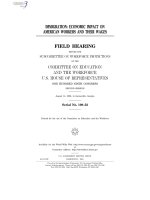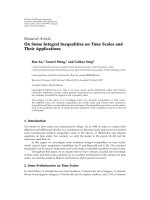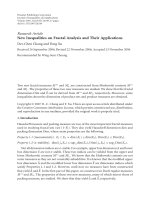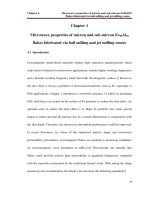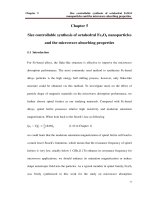Micromagnetic simulation on magnetic nanostructures and their applications
Bạn đang xem bản rút gọn của tài liệu. Xem và tải ngay bản đầy đủ của tài liệu tại đây (6.84 MB, 205 trang )
MICROMAGNETIC SIMULATION ON MAGNETIC
NANOSTRUCTURES AND THEIR APPLICATIONS
YONG YANG
(B. E., LANZHOU UNIVERSITY, CHINA)
A THESIS SUBMITTED
FOR THE DEGREE OF DOCTOR OF PHILOSOPHY
DEPARTMENT OF MATERIALS SCIENCE AND ENGINEERING
2014
I
Declaration
I hereby declare that this thesis is my original work and it has been written by me
in its entirety.
I have duly acknowledged all the sources of information which have been used in
the thesis.
This thesis has also not been submitted for any degree in any university
previously.
Yong Yang
1/14/2014
II
Acknowledgements
First, I would like to express my sincere appreciation to my supervisor Prof. Jun Ding
in Materials Science and Engineering Department (MSE) of National University of
Singapore (NUS), for his guidance and encouragement throughout my PhD study. His
patience, enthusiasm, creative ideas and immense knowledge shined the light for me
in all my research work and writing of this thesis.
I also would like make a grateful acknowledgement to Dr Haiming Fan and Dr Jiabao
Yi for helping me revise my manuscripts. Moreover, I greatly appreciate the kind
assistance from Ms Xiaoli Liu, Dr Yang Yang and Ms Yunbo Lv for the sample
preparation. Also, I would like to acknowledge all my research group members: Dr
Tun Seng Herng, Dr Jie Fang, Dr Li Tong, Dr Xuelian Huang, Dr Weimin Li, Dr
Dipak Maity, Mr Wen Xiao, Mr Xiaoliang Hong, Ms Olga Chichvarina, Ms Viveka
Kalidasan.
A special mention is given to the lab officers in Department of Materials Science and
Engineering for their technical support in sample characterization.
Additionally, I would like to offer my deep gratitude to the financial support provided
by the China Scholarship Council (CSC).
Last but not least, I would like thank to my family: my parents for giving birth to me
and supporting me throughout my life; and my wife, Ms Yanwen Wang, for her
accompanying all the way.
III
List of Publications
Yong Yang, Yang Yang, ChyePoh Neo and Jun Ding, A Predictive Method for High
Frequency Complex Permeability of Magnetic structures (2014 submitted)
Yong Yang, Xiaoli Liu, Yang Yang, Yunbo Lv, Jie Fang, Wen Xiao and Jun Ding
Synthesis and Enhanced Magnetic Hyperthermia of Fe
3
O
4
Nanodisc (2014
submitted)
Yong Yang, Xiaoli Liu, Jiabao Yi, Yang Yang, Haimin Fan and Jun Ding, Stable
Vortex Magnetite Nanorings Colloid: Micromagnetic Simulation and Experimental
Demonstrat-9
Yong Yang, Yang Yang, Wen Xiao and Jun Ding
J. Appl. Phys. 115
(2014), 17A521
Weimin Li, Yong Yang, Yunjie Chen, T.L. Huang, J.Z. Shi, Jun Ding,“Study of
magnetization reversal of Co/Pd bit-patterned media by micro-J.
Magn. Magn. Mater. 324 (2012), 1575-1580.
Yang Yang, Xiaoli Liu, Yong Yang, Wen Xiao, Zhiwen Li, Deshen Xue, Fashen Li,
Jun Ding, “ Synthesis of nonstoichiometric zinc ferrite nanoparticles with
extraordinary room temperature
Chem. C 1 (2013), 2875-2885.
Jie Fang, Prashant Chandrasekharan, Xiaoli Liu, Yong Yang, Yunbo
Chang-Tong Yang and Jun Ding -small
Gd
2
O
3
nanoparticles for improved T1- Biomaterials 35,
(2014),1636-1642.
Xiaoli Liu, Eugene Shi Guang Choo, Anansa S. Ahmed, Ling Yun Zhao, Yong Yang,
Raju V. Ramanujan, Jun Min Xue, Dai Di Fan, Hai Ming Fan and Jun Ding,
-loaded polymer nanospheres a
J. Mater. Chem. B 2 (2014), 120-128.
Awards
2013: ICMAT 2013 Best Poster Award
2012: Best Poster Award at the 5th MRS-S Conference on Advanced Materials
IV
Table of Contents
Declaration I
Acknowledgements II
List of Publications III
Table of Contents IV
Summary IX
List of Figures XV
List of Tables XXI
CHAPTER 1: Introduction 1
1.1 Micromagnetics 3
1.1.1 Theory of Operation 3
1.1.2 Micromagnetic packages 8
1.1.3 Application of micromagnetics 8
1.2 Magnetic nanostructures 12
1.2.1 Magnetism of magnetic nanostructures 12
1.2.2 Fabrication of magnetic nanostructures 18
1.2.3 Applications of magnetic nanostructures 23
1.2.3.1 Ferrofluids 25
1.2.3.2 Magnetic Hyperthermia 29
V
1.2.3.3 Microwave Electromagnetic (EM) Applications 33
1.3 Research objectives 39
1.4 Scope of the thesis 40
CHAPTER 2: Fabrication, Characterization and Micromagnetic Simulation
Techniques 42
2.1 Fabrication 43
2.1.1 Synthesis Fe
3
O
4
nanodiscs 43
2.1.2 Synthesis Fe
3
O
4
nanorings and nanorods 45
2.1.3 Synthesis of Fe
3
O
4
nanoparticles 45
3.2.3 Synthesis of phosphorylated-MPEG modified Fe
3
O
4
nanoring 46
2.2 Characterization 47
2.2.1 X-ray Diffraction (XRD) 48
2.2.2 Scanning Electron Microscopy (SEM) 49
2.2.3 Transmission Electron Microscopy (TEM) 51
2.2.4 Dynamic Light Scattering (DLS) 53
2.2.5 Vibrating Sample Magnetometer (VSM) 54
2.2.6 Superconducting Quantum Interface Device (SQUID) 56
2.2.7 Magnetic Hyperthermia 57
2.2.8 PNA Network Analyzer 59
2.3 Micromagnetic Simulation 62
VI
CHAPTER 3: Stable Vortex Fe
3
O
4
Nanorings Colloid: Micromagnetic Simulation
and Experimental Demonstration 65
3.1 Introduction 66
3.2 Methods 69
3.3 Results and Discussion 71
3.3.1 Micromagnetic modeling of Fe
3
O
4
nanorings 71
3.3.2 Stability of phosphorylated-MPEG Fe
3
O
4
nanoring colloid 85
3.4 Conclusion 89
CHAPTER 4: Magnetic Hyperthermia of Fe
3
O
4
Nanoring 90
4.1 Introduction 91
4.2 Methods 92
4.2.2 Micromagnetic simulation setup 92
4.2.3 Magnetic Hyperthermia Measurement 93
4.3 Results and discussion 93
4.4 Conclusion 100
CHAPTER 5: Magnetic Hyperthermia of Fe
3
O
4
Nanodiscs 102
5.1 Introduction 103
5.2 Methods 104
5.2.2 Micromagnetic simulation setup 104
5.2.3 Magnetic Hyperthermia Measurement 105
VII
5.3 Results and discussion 105
5.4 Conclusion 121
CHAPTER 6: A Predictive Method for Microwave Permeability of Magnetic
Nanostructures 122
6.1 Introduction 123
6.2 Theoretical Model and Experiment 125
6.2.1 Micromagnetic simulation for magnetic domain evaluation. 125
6.2.2 The calculation of complex permeability for single magnetization 126
6.2.3 The calculation of local effective magnetic field (H
eff
) 127
6.2.4 Average complex permeability of magnetic nanostructure 129
6.3 Results and Discussion 130
6.3.1 130
6.3.2 H
eff
in single domain nanosphere and nanorod 131
6.3.3 Microwave permeability of single domain nanosphere and nanorod136
6.3.4 Comparison with micromagnetic simulation 142
6.3.5 The bond between resonance frequency and initial permeability in
TFC 144
6.3.6 Comparison between experiment and the present model 146
6.3.7 Influence of orientation on the permeability of nanodisc 160
6.4 Conclusion 163
CHAPTER 7: Conclusions and Future Work 165
VIII
7.1 Conclusions 166
7.2 Future works 170
References 174
IX
Summary
In this project, we investigated the static and dynamic magnetic applications (i.e.
ferrofluid, hyperthermia, microwave permeability) of different Fe
3
O
4
magnetic
nanostructures (i.e. nanoparticle, nanoring, nanodisc and nanorod) fabricated by
chemical methods. During investigation, 3D Landau-Liftshitz-Gilbert (LLG)
micromagnetic simulation was used as theoretical guidelines. Upon performing the
micromagnetic simulation, we could look into the microcropic magnetic domain
structures, which are crucial for both static (i.e. hysteresis loops) and dynamic
magnetic properties (i.e. microwave permeability). Comparisons between the
simulated and experimental results were also provided closely for verification. In the
first part, a new kind of stable Fe
3
O
4
nanoring colloid based on the vortex domain
structure was developed by micromagnetic simulation and subsequently experimental
demonstration. Compared with the conventional ferrofluid containing
superparamagnetic nanoparties, the Fe
3
O
4
nanoring colloid could achieve much better
magnetic response due to the ferromagnetic nature of the large Fe
3
O
4
nanoring.
Meanwhile, the high colloidal stability can be also retained because of weak magnetic
X
interaction resulting from the flux closure vortex domain structure. Secondly,
magnetic hyperthermia properties of the Fe
3
O
4
nanoring were investigated. The
results suggest that the specific absorption rate (SAR) of nanoring is much higher than
the conventional superparamagnetic nanoparticles. Similar hyperthermia
measurement was conducted on the Fe
3
O
4
nanodiscs, it was found that the nanodisc
could achieve excellent SAR due to their prominent flipping Brownian relaxation
superior to the spherical nanoparticles. Besides ferrofluid and hyperthermia, the
microwave permeability of Fe
3
O
4
nanostructures was also studied. More importantly,
a predictive method was established for the calculation of high frequency
permeability of magnetic nanostructures. Compared with traditional theoretical
method, this method could consider both the magnetic domain structure and wave
orientation into account, which enables us to predict the microwave permeability of
various magnetic nanostructures at different wave orientations. The above results
were summarized as below:
1) Through micromagntic simulation, we have proposed a theoretical guide
for the formation of vortex domain in Fe
3
O
4
nanoring. Firstly, stable
vortex area (SVA), where both ground state and remanence state are
XI
vortex domain structure, was
diameter ratio of magnetite nanoring). Secondly, the investigation on
crystalline orientation effect suggested that the [113]-orientation is
favored for larger SVA area. In additionally, the existence of irregularity
would enlarge SVA dramatically. The simulation of inter-rings interaction
indicated that the minimal inter-rings distance for the formation of vortex
at remanence is about 20 nm. Based on the simulation, stable Fe
3
O
4
nanoring colloid was fabricated using phosphorylated-MPEG modified
Fe
3
O
4
nanorings. The colloidal stability and magnetic response ability
were confirmed by Dynamic Light Scattering (DLS) results and magnetic
response experiment.
2) The magnetic hyperthermia properties of the Fe
3
O
4
nanoring colloid were
investigated. Compared with the traditional superparamagnetic Resovist,
the Fe
3
O
4
nanorings exhibit a sig of SAR, which is an
order of magnitude higher at relative high AC magnetic fields (>500 Oe).
By comparing the SAR values measured in aqueous suspension with that
measured in gel suspension, it was found that the huge heat generated
under AC magnetic field was mainly from the hysteresis loss, which was
XII
reproduced micromagnetically by simulating average hysteresis loop on
the assumption of random orientation. This work may shed light on high
efficiency heating agent for magnetic hyperthermia cancer treatment.
3) In addition to the Fe
3
O
4
nanorings, the Fe
3
O
4
nanodiscs with different
sizes were also successfully fabricated and their hyperthermia properties
were investigated. The micromagnetic simulation revealed distinct
domain structures for the fabricated nanodiscs. The hyperthermia
properties of CTAB coated nanodiscs were measured in both water and
gel suspension. Additionally, two references samples, namely
superparamagnetic nanoparticles (SNP) and ferrimagnetic nanoparticles
(FNP), were also measured for comparison. The results measured in
aqueous suspension suggest that the nanodiscs exhibit excellent heat
dissipation ability, which is almost 6 and 2 times higher than the
traditional SNP and FNP, respectively. By contrast, in gel suspension the
nanodisc exhibit slightly higher SAR values than FNP, which is
demonstrated micromagnetically by simulating the hysteresis loss. The
SAR differences between the water and gel suspension suggested a
significant Brownian relaxation loss (about 2 kW/g at 0.3 kOe), which is
XIII
about 8 times higher than that of the isotropic nanoparticles with equal
volume (i.e. FNP). Based on this phenomenon, a stirring Brownian
relaxation model was proposed for the disc shaped nanostructures as
follows. When subjected in the alternating field, the nanodisc in aqueous
suspension could flip and stirring the water, thus converting the field
energy into the kinetic energy of surrounding carrier. In comparison, the
Brownian relaxation of traditional spherical nanoparticles only relies on
the friction between nanoparticles and carrier. Therefore, the heating
efficiency of the nanodisc should be much higher than spherical
nanoparticles. This study may open a new window for high efficiency
magnetic hyperthermia.
4) A predictive model was developed for the calculation of microwave
permeability of magnetic nanostructures, which could consider both the
domain structure and wave orientation into account. In this model, starting
from the ground state magnetic domain structures, a local effective field
(H
eff
) was evaluated within each mesh cell (discrete unite in
micromagnetism) by micromagnetic simulation. At a relative orientation
XIV
of magnetic domain structure with respect to the microwave, a
permeability spectrum can be calculated by using the local H
eff
and
subsequent average over all the cells. Equipped with this model, it was
found that the initial permeability remains the same while the resonance
frequency could be well tuned by changing the relative angle between
wave vector and magnetization. Based on this fact, a bond between initial
permeability and resonance frequency was proposed for the transverse
field case (TFC), where the microwave magnetic field is parallel to the
magnetic moment. Moreover, the validity of the present model was
proved by the good agreement between the experimental permeability and
our calculation on different Fe
3
O
4
nanostructures (i.e. octahedral,
nanodisc, nanorod, and nanorings). All these results indicated that the
present model could predict the microwave magnetic properties of
different nanostructures. It is believed that this model could offer valuable
guidance for the design of microwave devices.
XV
List of Figures
Figure 1.1 FE discretization of a sphere in micromagnetic simulation.
Figure 1.2 Spin dynamics interpreted by LLG equation.
Figure 1.3 Simulated hysteresis loop and reversal mechanism for a cone where
diameter and height are XV100nm. The applied field is along x direction.
Figure 1.6 Left: A plot of magnetic coercivity (H
c
) vs. particles size.
Figure 1.7 Surface spin disorder in a 2.5 nm particle.
Figure 1.8 Shape effect on the spin configuration of magnetic nanostructures. (a)
Calculated magnetic phase diagram for disk-shaped permalloy elements. (b)
Magnetic phase diagrams for rings with different inner to outer diameter ratio (). F,
V, and O indicate ferromagnetic out-of-plan
Figure 1.9 Magnetic switching processes of different magnetic nanostructures.
Figure 1.10 Schematic illustration of the hydrothermal thermal formation process for
-Fe
2
O
3
nanostructures mediated by phosphate and sulfate Ions.
Figure 1.11 Schematic drawing of ferrofluid. The fluid is appears to consist of small
magnetic particles dispersed in a liquid (left). Each particle consists of a single
domain iron oxide core, and a surface grafted with surfactant (right).
Figure 1.12 Potential energy (P.E.) as a function of interparticle (surface-to-surface
separation) distance . The particle diameter d is 10 nm.
Figure 1.13 Illustration of interacting magnetic nanoparticles. (a) Isolated
superparamagnetic nanoparticles due to superparamagnetic relaxation. (b) Interacting
ferromagnetic nanoparticles forming a dipole glass. (c) Interaction ferromagnetic
nanoparticles forming a chain with aligned dipole moments.
Figure 1.14 Illustration of Néel and Brownian relaxation of magnetic nanoparticles
exposed in external magnetic field.
Figure 1.15 Illustration of Frequency dependent permeability spectrum of
ferromagnetic material. The spectrum is divided into 5 regions, namely region I (<10
Hz, low frequency band), region II (10
4
-10
6
Hz, midfrequency band), region III
(10
6
-10
8
Hz, high frequency band), region IV (10
8
-10
10
Hz, microwave frequency
band) and region V (>10
10
Hz, extremely high frequency band). Note that the eddy
current loss is neglected.
XVI
Figure 2.1 Scheme of synthesis of Fe
3
O
4
nanodiscs.
Figure 2.2 Scheme of the fabrication of phosphorylated-MPEG modified Fe
3
O
4
nanoring.
Figure 2.3 Schematic illustration of Bragg's law.
Figure 2.4 Schematic illustration of SEM.
Figure 2.5 Schematic illustration of TEM (bright field mode).
Figure 2.6 Schematic illustration of DLS set-up.
Figure 2.7 A schematic illustration of VSM set-up.
Figure 2.8 A schematic diagram of SQUID system.
Figure 2.9 A schematic diagram of magnetic hyperthermia system.
Figure 2.10 Generalized PNA network analyzer block diagram.
Figure 2.11 Snapshot of LLG Micromagentic Simulator
TM
Figure 3.1 Illustration of the geometry and coordinate of magnetite nanoring.
D
in
/D
out
.
Figure 3.2 (a)-(c) The simulated ground states (F
out
, Vortex and Onion, respectively)
of magnetite nanorings with different geometry. The domain structure in each figure
is presented by both 2D (i.e. left, the color indicates the direction of magnetization
according to the color code) and 3D (i.e. right) micromagnetic configurations from the
top, middle and bottom planes of magnetite nanorings. The cartoons illustrate the
effective magnetization direction in each state. (d) Ground state phase diagram of
magnetite nanorings as a function of T and D
out
black triangles), 0.6 (red
squares) and 0.4 (blue circles). Solid symbols show the boundaries between the vortex,
F
out
(out-of-plane ferromagnetic) and F
in
(in-plane ferromagnetic) configurations. The
lines are a guide to the eye.
Figure 3.3 Simulated hysteresis loops of magnetite nanorings in the vortex region of
ground state phase diagram () at the same D
out
=70 nm but different T values (a)
T=50 nm. (b) T=30 nm. The insets show the field direction and snapshots during the
transition. The cartoons in the hole of snapshots are schematic diagrams of the
corresponding domain structures.
Figure 3.4 The observed remanence states of the magnetite nanorings within the
vortex region of the ground state phase diagram at (a) =0.4, (b) 0.6, (c) 0.8. During
the computation of remanence state, the field is applied along x direction. The
XVII
symbols represent computed points, the areas highlighted by dashed lines are the SVA.
(d)-(e) Twist and helix metastableremanence states, respectively.
Figure 3.5 The in-plane remanence state of the notched and off-centered magnetite
nanorings with geometry outside SVA (D
out
. (a) The
remanence configuration of magnetite nanoring with a notch about 5 nm (highlighted
by red dash circle) on the left arm. (b) The remanence configuration of the
off-centered nanoring with the center of the inner hole moved 2 nm away from the
magnetite nanoring axis.
Figure 3.6 The demagnetizing curves and remanence domain structures of double
magnetite nanorings (D
out
with different inter-particle
distances and way of stack. (a)-(b) Horizontally stack with a 20 and 15 nm
shoulder-to-shoulder distance, respectively. (c) Vertical stack with a 2 nm
head-to-head distance. All the fields are applied along x direction, as defined in figure
7(a). The ways of stack and corresponding remanence domain structures of each
nanoring are illustrated in each figure.
Figure 3.7 (a) The SEM image of magnetite nanorings. The inset is the D
out
distribution. (b) Hysteresis loop of magnetite nanorings measured at 5 K. (c)
Hydrodynamic diameters (d
hyd
) of phosphorylated-MPEG modified magnetite
nanorings measured at the time when it is prepared and one month later. (d) The effect
of pH on the mean d
hyd
of phosphorylated-MPEG modified magnetite nanorings.
Figure 3.8 (aI) The image of prepared phosphorylated-MPEG modified magnetite
nanoring aqueous colloid with the concentration of 0.07 g/l. (aII) 30 minutes later
under external magnetic field. (aIII) After removing magnet and gentle shake. (bI-bIII)
illustration of the magnetic domain evolution corresponding to figure 9(aI-aIII).
Figure 4.1 (a)-(b) TEM images of Fe
3
O
4
nanorings (c) Hydrodynamic diameters of
Fe
3
O
4
nanorings dispersed in water. Inset: Photograph showing the aqueous
dispersion of Fe
3
O
4
nanorings. (d) Room temperature hystersis loops of Fe
3
O
4
nanorings (NRs) and Resovist.
Figure 4.2 (a)-(b)Temperature vs. time curve of Fe
3
O
4
nanorings (NRs) and Resovist
aqueous suspension with different Fe concentrations (0.05, 0.1, and 0.2 mg/mL) under
an AC magnetic field (600 Oe, 400 kHz).
Figure 4.3 (a) Field dependent SAR values of Fe
3
O
4
NRs and Resovist measured in
water suspensions. (d) SAR values of Fe
3
O
4
NRs measured in water and gel
suspensions. The frequency of AC magnetic field is about 400 kHz.
Figure 4.4 (a) Simulated hysteresis loops along different directions with respect to the
Fe
3
O
4
NRs. The denotes the angle between ring axis and field direction. (b)
Comparison between simulated and experimental hysteresis loop.
XVIII
Figure 4.5 Comparison between simulated and experimental SAR value of Fe
3
O
4
nanoring in gel suspension at different frequencies of AC field.
Figure 5.1 SEM images of iron oxide nanodiscs (a)-(b) before and (c)-(d) after
reduction.
Figure 5.2 TEM, HRTEM and SAED images of the Fe
3
O
4
nanodiscs.
Figure 5.3 (a) XRD and (b) VSM of Fe
3
O
4
nanodiscs.
Figure 5.4 Simulated ground state phase diagram of Fe
3
O
4
nanodisc and magnetic
domain structures of D1 and D2 (bottom).
Figure 5.5 (a) Simplified process scheme, (b) FT-IR spectrum of CTAB, plain Fe
3
O
4
nanodisc and CTAB-capped Fe
3
O
4
nanodiscs. (c) DLS spectrum of CTAB-capped
Fe
3
O
4
nanodiscs.
Figure 5.6 (a) illustration of experimental setup for hyperthermia testing. (b)-(c)TEM
and SEM images of reference samples, namely Fe
3
O
4
superparamagentic
nanoparticles (SNP) and ferrimagentic nanoparticles (FNP), respectively. (d)Time
dependent temperature rise of 1 ml samples with 0.1 mg/ml concentration on
exposure to 0.4 Oe alternating field at 488 kHz frequency.
Figure 5.7 SAR values of CTAB-capped Fe
3
O
4
nanostructures in gel and aqueous
susceptions at different magnetic field strengths with 488 kHz frequency.
(a)Superparamagentic nanoparticles (SNP), (b)Ferrimagentic nanoparticles (FNP),
and (c)-(e)nanodiscs. The inset in (a) illustrates the comparison between the
experimental and theoretical SAR values of SNP.
Figure 5.8 (a) Simulated average hysteresis loops of different Fe
3
O
4
nanostructures.
(b) Simulated magnetic domain evolution of D2. (c) Comparison between the
experimental and simulated hysteresis loss.
Figure 5.9 Comparison of Brownian Loss between different Fe
3
O
4
nanostructures.
Figure 5.10 Illustration of Brownian Loss of nanodiscs and spherical nanoparticles
Figure 6.1 (a) Illustration of domain structure of a magnetic nanorod at equilibrium
state. The spins are parallel to the local effective anisotropy field (H
eff
). (b) The
magnetic moments precess about H
eff
because of an incident microwave. h and k
denote the magnetic component and wave vector, respectively. (b) SW rotation of M
under external field h
o.
Figure 6.2 of SW model.
Figure 6.3 (a) Magnetic domain structure of 20 nm single domain Fe nanosphere. (b)
3D H
eff
mapping and (c) H
eff
count.
XIX
Figure 6.4 (a) Magnetic domain structure and (b) H
eff
distribution and mapping of Fe
rod with 20 nm in diameter and 200 nm in length.
Figure 6.5 Microwave permeability spectrums single domain Fe sphere (D=20 nm) at
different relative orientations. is the angle between the wave vector and magnetic
moment of sphere.
Figure 6.6 Microwave permeability spectrum of single domain Fe nanorod at
different relative orientations. is the angle between the wave vector and rod. The
microwave magnetic field is fixed along x direction (perpendicular to the rod)
Figure 6.7 High frequency permeability of Fe nanorods (D=20 nm, H=200 nm)
calculated by present mode and micromagnetic simulation (OOMMF). In the
calculation of present model, the microwave vector is parallel to the nanorod, namely
the Longitudinal Field Case (LFC).
Figure 6.8 Orientation dependent Snoek ratio of single domain nanorods. The
dimensions of the nanorod are the same (D=20 nm, H=200 nm). The Snoeks limit are
provided (green line) for comparison.
Figure 6.9 SEM images of the synthesized Fe
3
O
4
nanostructures. The insets illustrate
the mean dimension and crystalline orientation.
Figure 6.10 Ground state of the synthesized Fe
3
O
4
(a) nanorod, (b) nanodisc,
(nanoring) and (d) octahedral.
bottom slice perpendicular to the z direction.
Figure 6.11 Local H
eff
mapping of the synthesized Fe
3
O
4
nanostructures. The colour
represents the magnitude of local H
eff
according to the colour bar. The H
eff
count is
also provided in the bottom of each mapping. The corresponding relative orientation
of external field h
0
and nanostructure are illustrated as inset.
Figure 6.12 scheme of the average of
for composite samples.
Figure 6.13 Calculated intrinsic permeability of Fe
3
O
4
calculation.
Figure 6.14 Measured permeability of Fe
3
O
4
/paraffin composite (20 vol%).
Figure 6.15 The calculated intrinsic permeability of Fe
3
O
4
nanostructures.
Figure 6.16 Comparison between experimental and calculated
as well as f
r
for
Fe
3
O
4
nanostructures.
Figure 6.17 Calculated permeability of Fe
3
O
4
nanodisc with different degree of
orientation. The cartoon on left side illustrates three scenarios of orientation. In the
+-0
o
oriented case, the magnetic field h
0
is strictly in the plane of nanodisc. In the
XX
+-15
o
oriented case, the angle between the magnetic field h
0
and the plane of nanodisc
could varies from -15
o
to +15
o
, including 0
o
. The unoriented case means a random of
distribution of nanodisc in the non-magnetic matrix.
Figure 6.18 Experimental permeability of oriented and unoriented Fe
3
O
4
nanodisc/paraffin composite. The inset shows the method for alignment.
Figure 7.1 (a) illustration of 2D array of binary magnetic element. The magnified
picture shows the 3-layer structure of the nanomagnet. (b) Field controlled switch of
magnetic domain structure in the nanomagnet.
XXI
List of Tables
Table 1.1 Comparison of the chemical methods for the synthesis of magnetic
nanostructures.
Table 1.2 Synthesis conditions for different -Fe
2
O
3
nanocrystals.
Table 2.1 Instruments for characterization.
Table 2.2 Typical parameter of magnetic materials used in micromagnetic simulation.
Table 5.1 Dimensions and the static magnetic properties of Fe
3
O
4
nanodisc. AR
denotes the Aspect Ratio (Diameter/thickness). M
s
and H
c
are the saturation
magnetization and coercivity, respectively.
Table 6.1 List of H
a
and calculated H
eff
of different single domain nanospheres (D=
20 nm).
Table 6.3 List of resonance frequency (f
r
) and initial permeability (
) of single
domain magnetic nanospheres (D=20 nm) calculated by present model and analytical
formulas.
Table 6.2 List of H
a
and calculated H
eff
of single domain nanorods (D= 20 nm, L=
200 nm).
Table 6.4 List of resonance frequency (f
r
) and initial permeability (
) of single
domain magnetic nanorods (D=20 nm, L=200 nm) calculated by present model and
analytical formulas.
Table 6.5 Summary on the angular resonance frequency
, the product of angular
resonance frequency and initial permeability
for single domain
nanoparticles. The upper script (LFC or TFC) indicates the relative orientations of
magnetic moment with respect to the vector.
.
Table 6.6 Static magnetic properties of Fe
3
O
4
nanostructures.
Table 6.7 The calculated
of different Fe
3
O
4
nanostructures.
Chapter 1: Introduction
1
CHAPTER 1: Introduction
Chapter 1: Introduction
2
Magnetic nanostructure has attracted intensive attention in recent years due to the
rapid progress in fabrication and processing. When the dimension of magnetic
structure is reduced into nanometer regime, small variations in the shape and size
become on the magnetic properties.
1-2
The domain evolution is
one of the most important reasons. For the sake of energy minimum, different shape
would prefer distinct magnetic domain structures, which is responsible for dramatic
change in both static and dynamic magnetic behaviors. Meanwhile, the size also plays
an important role in the determination of domain structure. When size is below a
critical value, the magnetic nanostructure becomes single domain. Further decrease in
the size would result in the so called superparamagnetism with fascinating magnetic
properties, which promotes a huge amount of applications especially in biomedicine
area.
3-4
5
Therefore, the size and shape dependent properties of magnetic
nanostructures are of great interest in both physics and material science.
At the same time, the ever-growing interest in the magnetic nanostructures promotes
the fast development of micromagnetism. The micromagnetic theory, based on the
well known Landau-Lifshitz equation, has been found experimentally and
theoretically to yield an accurate description of the time evolution of spin
configuration. With the help of micromagnetic simulation, we can obtain direct
visualization of static and dynamic magnetic properties
of magnetic structures. More importantly, as a powerfully theoretical tool, it enables
Chapter 1: Introduction
3
us to predict the magnetic properties, which is absolutely useful for the design of
magnetic devices with desired function. Based on this fact as well as the ever growing
high speed computing, the micromagnetism has become an indispensable branch in
material science.
In this thesis, we devoted to apply the micormagnetic simulation on different
magnetic nanostructures (i.e. nanoring, nanodisc, nanorod, etc.) and their possible
applications. Generally, the application of magnetic nanostructures involves nearly all
research topics in material science. Herein, three types of applications are mainly
investigated, namely ferrofluid, magnetic hyperthermia and microwave nature
resonance, which are differentiated by their distinct working frequencies. For instance,
the magnetic colloid is a static (zero frequency) application, while the magnetic
hyperthermia and microwave nature resonance are two kinds of dynamic applications,
working at radio frequency (sub-megahertz) and microwave frequency (gigahertz).
Other applications are beyond the scope of the current thesis. In this chapter, we will
present an introduction on the micromagnetism. Then an overall review on the
magnetic nanostructures and their applications will be provided in the following
sections.
1.1 Micromagnetics
1.1.1 Theory of Operation
